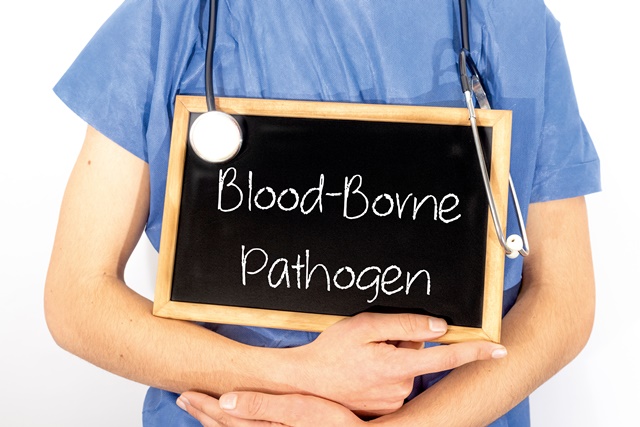
The world is entirely focused on preventing the spread of the COVID-19 virus via social distancing, lockdowns, and encouraging vaccinations.
However, other threats deserve some attention, especially with more and more people getting the anti-COVID19 jabs—bloodborne diseases.
This article discusses basic knowledge about bloodborne pathogens and diseases.
What Are Bloodborne Diseases?
Infectious pathogenic microorganisms cause bloodborne diseases—bacteria or viruses—carried in the blood and other bodily fluids. Potentially infectious body fluids include:
- Vaginal secretions
- Semen
- Saliva
- Pleural fluid (covers the lungs)
- Cerebrospinal fluid (surrounds the spinal cord and brain)
- Amniotic fluid (surrounds an unborn baby)
- Synovial fluid (responsible for lubricating your joints)
- Peritoneal fluid (lubricates the pelvic cavity and abdominal wall and covers most abdominal organs)
- Any body fluid that’s visibly contaminated with an infected blood
The most common bloodborne pathogens are hepatitis B and C virus (HBV and HCV) and the human immunodeficiency virus or HIV. Not only are these three so common, but they are also the most problematic and devastating.
Other than these three, over 20 different pathogens can be transmitted via an infected person’s blood and bodily fluids, such as brucellosis and syphilis.
Meanwhile, some pathogens are bloodborne but aren’t precisely classified this way. For instance, the West Nile virus, Zika, and malaria are considered vector-borne diseases even though the virus is found in an infected person’s blood.
Unlike HIV or brucellosis, these pathogens aren’t spread from one person to another. Instead, people are infected through other means.
For instance, the West Nile virus spreads through infected mosquitoes feeding on infected birds.
How It Spreads And The Risk of Infection
A bloodborne pathogen spreads when an uninfected individual comes in contact with an infected person’s or animal’s blood.
However, a simple contact doesn’t mean you’ll get infected right away. Contact with healthy skin holds the lowest risk of infection.
However, it’s still best to avoid it as much as you can.
Direct contact with infected blood has the highest risk of infection.
Sharing hypodermic needles and sexual contact are the two main methods of actual transmission and infection.
Infected mothers can transmit bloodborne pathogens to their unborn babies. The risk only increases during birth when the placental barrier no longer protects the baby.
Contact between mucus membranes of the eyes, nose, mouth, or genital regions even without traditional sex can also pass bloodborne pathogens along.
Meanwhile, there are numerous ways of contracting these infectious pathogens in a healthcare setting.
These include:
- Punctures from broken glass or sharp medical tools
- Needle sticks
- Accidental blood or bodily fluid contact with broken or damaged skin and mucus membrane
- Contaminated aerosols, for instance, when a patient coughs up bloody sputum
Who’s At Risk?
Healthcare professionals and public safety workers have the highest risk of contracting and getting infected with bloodborne pathogens.
However, even non-healthcare workers may become exposed at work while providing first-aid help to an injured co-worker and coming in contact with the injured person’s body fluid or blood.
A shortlist of professions that are at risk of accidental exposure to bloodborne pathogens are:
- Nurses, doctors, and other direct patient care providers
- Medical laboratory researchers and employees
- Dentists, dental assistants, and hygienists
- Dermatologists and cosmetologists
- Paramedics, firefighters, EMTs, and other first responders
- Healthcare providers at rehab or nursing home
- Law enforcement
- Medical equipment technicians
- Blood drive volunteers and blood and tissue bank staff
- Funeral home employees and morticians
- School nurses, teachers, and school employees
- Construction workers
- Piercing and tattoo artists
- Laundry, janitorial, and housekeeping workers
In general, anyone whose job could cause them to contact blood or potentially contaminated items such as syringes and needles are at risk of bloodborne pathogens.
How Long Can Pathogens Live Outside The Body?
This depends, as most bloodborne viruses can live for days or even weeks outside the body and still cause an infection.
Even dried blood can still transmit hepatitis C and B viruses, surviving for up to 4 days and a week, respectively.
Stopping The Spread Of Bloodborne Pathogens

Being a threat to your health, you need to follow certain precautions to stop the spread of bloodborne pathogens.
You need to treat all blood and bodily fluids as if they carry infectious bloodborne pathogens.
In the workplace, employers should establish safety protocols.
At-risk individuals should be required to wear appropriate personal protective equipment (PPE), including masks, gloves, face shields, eye protection, and gowns.
You also need to install authorized sharp and biohazard disposal containers. Ensure to properly dispose of syringes, needles, and other items that can cause transmission. Meanwhile, you must thoroughly disinfect re-used items and surfaces between uses.
Anyone at risk of exposure to bloodborne pathogens should undergo training and pass a bloodborne pathogen certification test. Then, ensure continuous training and education on these pathogens.
Never use the same intravenous needle as someone else in terms of personal precautions. If you’re getting a piercing or a tattoo, get It from a credible provider.
Ensure that the professional uses gloves and sterile equipment to avoid contamination.
Never take sexual risks. Always be selective of your partners and use protection.
Handling Exposure To Bloodborne Pathogens
Even the most careful individuals can still be accidentally exposed to bloodborne pathogens.
So, if you came in contact with these pathogens, what should you do?
It’s essential to act quickly. Immediately wash the area with water and soap. If you have an open wound, make it bleed by squeezing it gently while flushing with clean water.
If the infected fluid comes in contact with the eyes, you can rinse them with saline or sterile water.
Once clean, make sure to seek immediate medical attention. If it happens at work, make sure to follow the established exposure control plan, documenting and reporting the incident according to your workplace’s policy.
The Occupational Safety and Health Administration (OSHA) requires employers to water have post-exposure evaluations and offer follow-up appointments to their at-risk employees for free.
Conclusion
Bloodborne pathogens can cause a wide range of serious diseases—most of which are either fatal without immediate medical attention or don’t have any known cure yet.
So, we hope that this article has equipped you with enough knowledge and understanding about bloodborne pathogens and diseases. This way, you can adequately protect yourself and others from severe infection.
About The Author:
Silvia Olive is a healthcare professional. She writes blog posts and guest posts to share his knowledge and expertise with others. Silvia loves listening to music and playing guitar in her free time.




